As you get older, it’s important to pay attention to the transformations taking place in your body. In addition to hair graying, there is a decrease in your muscle mass, as well as your mobility, flexibility, balance, coordination, and strength. Yet, you can implement precautionary steps, like participating in routine physical exercises, to manage a lot of these bodily adjustments. Here, we will discuss some of the most vital daily stretching routines for individuals over 50 that can assist in maintaining a confident and self-sufficient lifestyle.
“Stretching allows [you] to extend, maintain, and preserve your range of motion, prevent injuries, aid in muscle recovery, decrease stress and pain, encourage blood flow and circulation, and promote body awareness,” explains Jennifer Harris, NASM-CPT and lead flexologist for StretchLab. “[As you age, you] want to maintain and increase your mobility, which is the marriage of strength and flexibility. Mobility increases your functionality. Mobility is a measurement of your quality of life in many ways.”
Now, let’s explore the essential daily stretches to do after 50. Make sure to check in with your healthcare provider before starting any new fitness routine to ensure it’s the best choice for you.
Cat/Cow
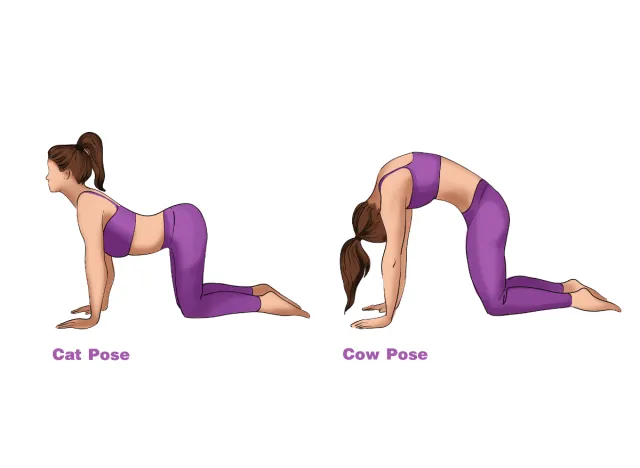

The cat/cow exercise is performed slowly and gently as you focus on your breathing. It will flex and extend your spine.
Begin by assuming a tabletop position. If it’s too hard on your knees, you can do it while standing with your knees lightly bent.
“Take a big breath as you drop your belly and look gently up, arching the spine,” instructs Harris. “Reverse that movement by breathing out while drawing the belly in and rounding the upper back, protracting the shoulder blades.”
Moving Neck Stretch
Moving neck stretches are dynamic exercises to help your neck and upper back stay tension-free.
“Sit or stand tall and drop your chin to your chest,” Harris says. “Relax your shoulder blades down the back. Start to draw small and slow half circles with your nose, feeling a stretch in your neck and into your trapezius muscles. Return to a neutral position and drop one ear to one shoulder, stretching the sides of your neck.”
Gradually work your way through these stretches, taking deep breaths and maintaining relaxed shoulders.
Lateral Side Bend
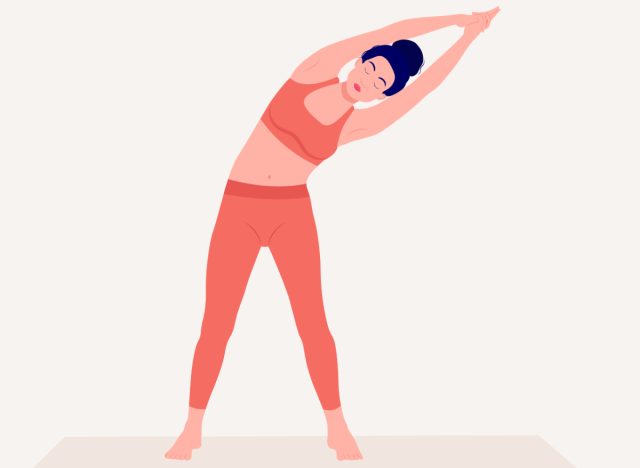

Performing lateral side bends will stretch out each side of your body, including your external obliques, latissimus dorsi, serratus anterior, and hips.
Harris instructs, “Stand or sit tall. Inhale to reach your arm up and exhale to reach over [until] you feel a stretch along the side-body. Try not to cave in your chest.”
This stretch can be completed while seated or standing. Hold it as a static stretch for a total of 30 to 45 seconds per side.
Spinal Twist
Adding gentle spinal twists to your routine will aid in mid-back mobility.
Begin sitting or standing tall. Breathe in, and on the exhale, twist your upper body to your left side, ensuring your hips stay square ahead of you. For an added stretch of the neck, turn your head to your left as well. Repeat on the other side, holding for 30 to 45 seconds each.
Cobra Pose
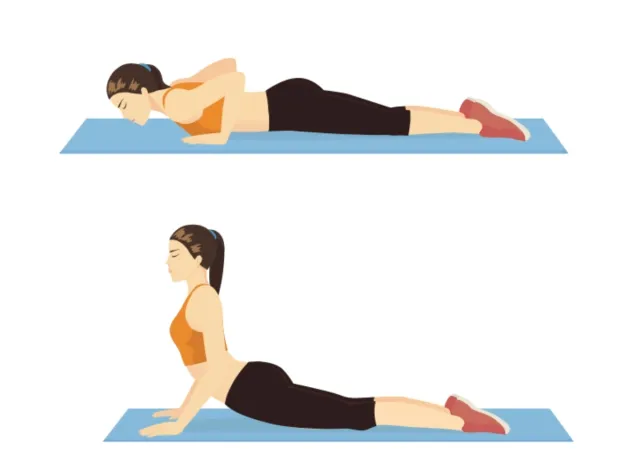

“This stretch works into your spinal extension and stretches the abdomen and chest,” explains Harris. “It also builds strength in the arms and shoulders.”
Start by lying flat on your stomach with your forearms placed beside your chest. Inhale and press your chest up, making sure your shoulders don’t creep toward your ears. Hold cobra pose for 30 to 45 seconds.
“This stretch can be regressed and performed with the elbows directly under the shoulders in a sphinx posture instead,” Harris says. “This stretch can also be performed against a wall if it is too uncomfortable to lie on your stomach.”
Straddle Stretch
Saddle stretch engages your hamstrings, inner thighs, and lower back.
Begin seated on the floor and widen your legs as far as you’re comfortably able to. Engage your quads and feet. Breathe in, and as you exhale, reach forward. Hold the stretch for 45 seconds to a full minute.
“You can walk your hands toward one side and the other to add some extra side-body stretching,” suggests Harris. “You can also flex your toes back toward your face to add a stretch to your calves!”
Figure Four Stretch
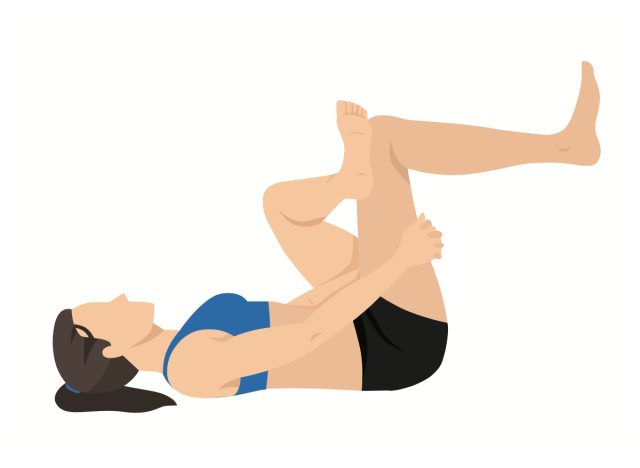

Get ready to fire up your hips and glutes with the figure four stretch.
Begin seated tall with both feet on the floor. Bring your left foot to meet your right thigh. Allow your left knee to fall openly. Hinge your body forward while keeping your back flat to feel a solid stretch in your glutes.
“This stretch can also be performed on your back,” Harris says. “Bend both knees, planting your feet on the floor. Cross one foot over the other thigh. Thread [your] hands through the space between the legs and around the non-stretching leg. The closer you draw your legs to your chest, the deeper the stretch.”
Hold the figure four stretch for 30 to 45 seconds.
Chest Stretch
“Since gravity works down on us all day long, it’s common for our chest muscles to get tight,” explains Harris. “We must counteract gravity by stretching out our chest.”
Begin sitting or standing tall. Reach both arms behind you. Aim to reach your hands together behind your back if you can comfortably. Hold this stretch for 30 to 45 seconds, all while taking deep breaths.
Low Lunge
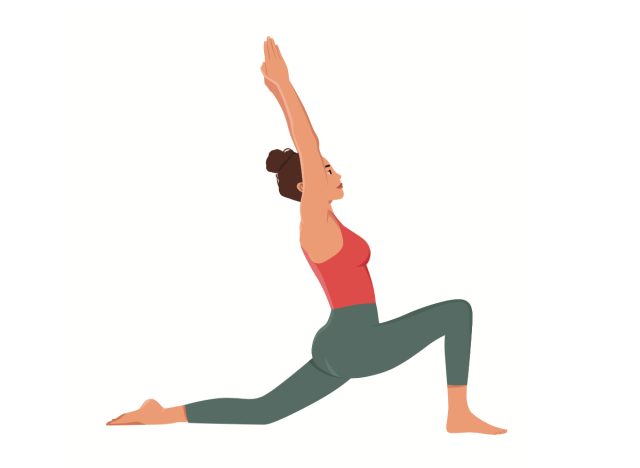

“Sitting often puts [your body] in a position where the muscles at the front of your hips (hip flexors) get tight, which can cause back pain,” Harris tells us. “It can pull your body out of alignment, affecting the entire kinetic chain.”
That’s where the low lunge comes in clutch. Begin kneeling and step one foot forward to assume a lunge. Bring your pelvis down to engage your abs and stretch your front hip.
“[If the pressure bothers your back knee, you may need to pad it up] or perform a lunge from a standing position with a slight bend in the back leg,” Harris offers. “If you lift your arms, it will create a bigger challenge by adding a balance component!”
Tree Pose
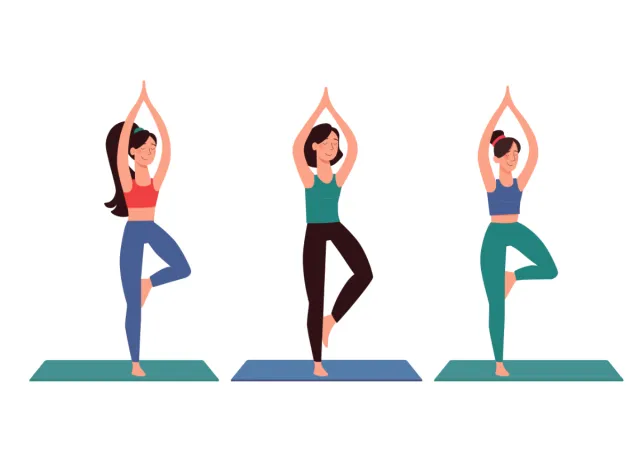

Tree pose stretches your hips and builds strength in the standing leg. In addition, it puts your balance to the test, which is crucial to continue working on as you grow older.
“Stand tall. Bring one leg off the floor and rest your foot below your knee on the inside of your shin,” instructs Harris. “Your toes should be facing down, and your knee abducted to the side. Focus on one spot somewhere nearby that is unmoving. Breathe slowly and deeply. If you feel strong and stable, reach your arms overhead like a mighty tree!”
Frequently Asked Questions
Why are daily stretches important after the age of 50?
As we age, our muscles tend to lose flexibility, leading to increased stiffness and a higher risk of injury. Daily stretches can help maintain and improve flexibility, reduce the risk of muscle strains, improve circulation, and enhance overall mobility and balance, making daily activities easier and promoting better quality of life.
How long should I hold each stretch?
It is generally recommended to hold each stretch for 15-30 seconds. This duration allows the muscles enough time to relax and lengthen, promoting flexibility and range of motion. Avoid bouncing while stretching, as it can lead to muscle tears or injuries.
Is it necessary to warm up before stretching?
Yes, it is vital to warm up before stretching, especially as we age. A light aerobic activity such as walking or cycling for 5-10 minutes can help increase blood flow to the muscles, making them more pliable and reducing the risk of injury during stretching. Warm muscles also respond better to stretching.
Can I do these stretches if I have existing health conditions?
If you have any existing health conditions or concerns, it is essential to consult with your healthcare provider before starting any new exercise or stretching routine. They can provide guidance on safe stretches based on your specific health needs and limitations.
Is it better to stretch in the morning or evening?
The best time to stretch is when you can be most consistent with your routine. Some people prefer stretching in the morning to invigorate and prepare their bodies for the day ahead, while others find stretching in the evening helps relax muscles and unwind after a day’s activities. Choose a time that works best for you and fits into your daily schedule.
Should I feel pain while stretching?
While you may feel some mild discomfort or tension while stretching, you should never feel sharp pain. Stretching should be gentle and should not cause pain. If you experience pain while stretching, ease off the stretch to prevent injury. Stretch only to the point of tension, and never force your body into painful positions.






